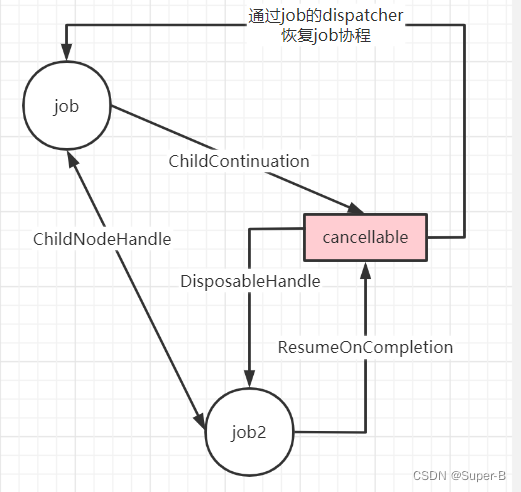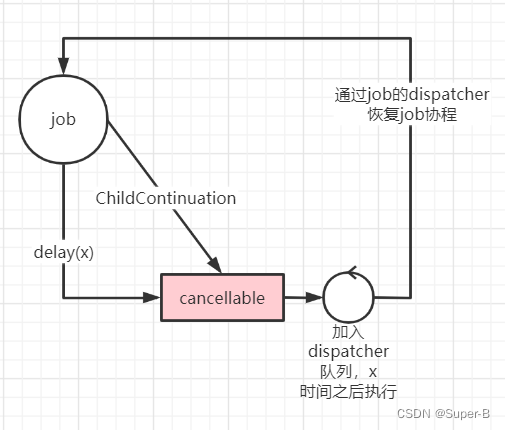suspend挂起函数
在idea中写某些协程函数的时候,会有一个绿色箭头图标的出现,如下图:

而且这些方法不放在协程里面写的话,idea编辑器还会报错,如下图:

上面所说的这些方法就是挂起函数,挂起函数必须要在协程中调用,或者在挂起函数中调用;放在挂起函数中调用挂起函数调用,那么说明还是间接在协程中被调用,也就是挂起函数调用需要协程环境。
在说挂起函数原理之前,先复习下 launch启动过程 所说的三类continuation:
- DispatchedContinuation用于分发continuation到指定的线程池中;
- ContinuationImpl用于包装launch的lambda代码块作为业务代码代理类;
- StandAloneCoroutine协程管理类管理Job生命周期以及协程的状态父子Job关系维护等等。
join原理
启动一个launch的时候,返回一个Job对象,这个Job对象对应着上面三个continuation实例,其中我们的业务代码在ContinuationImpl中,例如下面的代码:
val myScope = CoroutineScope(CoroutineName("name") + IO + Job())
val job = myScope.launch(CoroutineName("job")) {
var job2 : Job? = launch(CoroutineName("job2")) {
Thread.sleep(20000)
}
job2?.join()
printlnM("job has run to end")
}
printlnM("job has launch")
这段代码编译后的代码如下:
BuildersKt.launch$default(
myScope,
(CoroutineContext)(new CoroutineName("job")),
(CoroutineStart)null,
(Function2)(new Function2((Continuation)null) {
// $FF: synthetic field
private Object L$0;
int label;
public final Object invokeSuspend(@NotNull Object $result) {
Object var5 = IntrinsicsKt.getCOROUTINE_SUSPENDED();
switch(this.label) {
case 0:
ResultKt.throwOnFailure($result);
CoroutineScope $this$launch = (CoroutineScope)this.L$0;
//创建job2
Job job2 = BuildersKt.launch$default(/*省略。。。省略部分后面贴出*/)
this.label = 1;
//调用join方法
if (job2.join(this) == var5) {
return var5;
}
break;
case 1:
ResultKt.throwOnFailure($result);
break;
default:
throw new IllegalStateException("call to 'resume' before 'invoke' with coroutine");
}
MainActivity.Companion.printlnM("job has run to end");
return Unit.INSTANCE;
}
//省略。。。
}),
2, (Object)null);
Job job2 = BuildersKt.launch$default(/*省略。。。省略部分后面贴出*/)job2的省略代码后面贴出,不影响代码流程。
可以看到,我们的业务代码被编译到invokeSuspend()函数中了,是通过switch case语句来运行对应的代码逻辑,
第一步:case 0执行的是Job job2 = BuildersKt.launch$default(/*省略。。。*/) 也就是逻辑代码里面的创建job2那句代码,然后this.label = 1; ,label设置为1,接着调用job2.join()方法,join方法一般都是返回COROUTINE_SUSPENDED的,那么在这里就返回结束了,除了立马就有返回值的挂起函数返回值,这个if判断就不成立了,直接走下面第三步;
第二步:label为1了,那么case 1的情况成立,入参设置一下异常,这个入参是上一步传递进来的,没有异常的话这里是空的,break;
第三步:调用printlnM("job has run to end");打印语句。
我们可以看到,遇到有函数返回COROUTINE_SUSPENDED的,那么invokeSuspend函数会立刻return结束掉。按照之前 launch启动过程 分析的,launch的lambda逻辑代码被调用的调用链是:
DispatchedContinuation -> ContinuationImpl(内部调用了invokeSuspend) -> StandAloneCoroutine
如果invokeSuspend函数因为返回了COROUTINE_SUSPENDED直接结束掉的话,岂不是这个Job2协程的代码还没有跑完,就结束了?显然是不行的,仔细观察发现,只需要多次调用invokeSuspend方法,label会随着每次调用都会递增或者变动,那么对应的case一定会让所有的代码都执行一遍的。
可以把这种switch case语句当成是人们常说的状态机模式,在安卓开发中,常用的handler.sendMessage就很类似状态机模式,根据不同的what去处理不同的逻辑,只是协程会将顺序代码,根据case分成一个接着一个连续的代码段。
这里我们直接去跟踪join源码看是怎么实现的:
job2.join(this)
public final override suspend fun join() {
if (!joinInternal()) { // fast-path no wait
coroutineContext.checkCompletion()
return // do not suspend
}
return joinSuspend() // slow-path wait
}
private suspend fun joinSuspend() = suspendCancellableCoroutine<Unit> { cont ->
// We have to invoke join() handler only on cancellation, on completion we will be resumed regularly without handlers
cont.disposeOnCancellation(invokeOnCompletion(handler = ResumeOnCompletion(this, cont).asHandler))
}
主要看joinSuspend函数,里面有几个重要的点:
suspendCancellableCoroutine<Unit> { cont ->让当前协程在调用该函数处挂起,给当前协程的lambda代码块提供一个CancellableContinuation。
suspendCoroutineUninterceptedOrReturn { uCont ->
val cancellable = CancellableContinuationImpl(uCont.intercepted(), resumeMode = MODE_CANCELLABLE)
/*
* For non-atomic cancellation we setup parent-child relationship immediately
* in case when `block` blocks the current thread (e.g. Rx2 with trampoline scheduler), but
* properly supports cancellation.
*/
cancellable.initCancellability()
block(cancellable)
cancellable.getResult()
}
首先创建一个CancellableContinuationImpl类型的continuation,入参是uCont.intercepted(),这个uCont是调用的协程,那么就是val job这个协程,uCont.intercepted()也就是 launch启动过程 那章分析的DispatchedContinuation对象,由于val job = myScope.launch(CoroutineName("job")) 这句话已经将DispatchedContinuation生成了,所有会复用之前的对象,代码如下:
public fun intercepted(): Continuation<Any?> =
intercepted
?: (context[ContinuationInterceptor]?.interceptContinuation(this) ?: this)
.also { intercepted = it }
那么cancellable对象持有的就是val job的DispatchedContinuation,
接着在调用 cancellable.initCancellability():
private fun setupCancellation() {
//省略
val parent = delegate.context[Job] ?: return // fast path 3 -- don't do anything without parent
parent.start() // make sure the parent is started
val handle = parent.invokeOnCompletion(
onCancelling = true,
handler = ChildContinuation(parent, this).asHandler
)
parentHandle = handle
//省略
}
看代码,val handle = parent.invokeOnCompletion 之前分析过,是parent和当前job组成父子关系的作用,parent代表val job,当前job就是cancellable对象,意思就是父子Job可以相互取消对方,和之前父子Job关联的分析是差不多的,那么val job和cancellable组成了父子关系。
在调用 block(cancellable),这个就进入下面2了。
-
invokeOnCompletion(handler = ResumeOnCompletion(this, cont).asHandler),这个方法是将入参ResumeOnCompletion和当前的JobSupport关联起来,加入到当前Jobsupport.state.list中,asHandler返回一个DisposableHandler然后将这个handler加入到cont的state.list中去,cont也是上面1中变量cancellable,是CancellableContinuationImpl类型的继承自continuation,这样val Job2和新创建的cancellable也组成了父子关系了。 -
ResumeOnCompletion类型,传入的this,和cont参数,用来恢复cont协程的作用:
private class ResumeOnCompletion(
job: Job,
private val continuation: Continuation<Unit>
) : JobNode<Job>(job) {
override fun invoke(cause: Throwable?) = continuation.resume(Unit)
override fun toString() = "ResumeOnCompletion[$continuation]"
}
调用了invoke -> continuation.resume(Unit),这样continuation就会继续执行了。
经过上面的分析之后,可以看出整个Job树的结构如下:

看图:其中cancellable是可以被job取消的,取消之后,会将cancellable移除掉,cancellable被取消后,会遍历自己的state.list列表调用invoke方法,那么就会调用DIsposableHandle的invoke方法,将自己从job2中移除掉,cancellable就失去了作用。
结合一下job2的被编译后的代码,Job2编译后的代码如下:
BuildersKt.launch$default(
$this$launch,
(CoroutineContext)(new CoroutineName("job2")),
(CoroutineStart)null,
(Function2)(new Function2((Continuation)null) {
int label;
@Nullable
public final Object invokeSuspend(@NotNull Object var1) {
Object var2 = IntrinsicsKt.getCOROUTINE_SUSPENDED();
switch(this.label) {
case 0:
ResultKt.throwOnFailure(var1);
Thread.sleep(1000L);
return Unit.INSTANCE;
default:
throw new IllegalStateException("call to 'resume' before 'invoke' with coroutine");
}
}
//省略。。。
}),
2, (Object)null);
invokeSuspend方法被调用后,休眠了1s中,之后结束了,就会继续调用completion的resume方法,这样就会调用到job2对应的
AbstractCoroutine.resumeWith -> makeCompletingOnce ->
notifyHandlers(list: NodeList, cause: Throwable?) ->
(ResumeOnCompletion) node.invoke(cause) -> continuation.resume(Unit) ->
进入到CancellableContinuationImpl类中,
CancellableContinuationImpl.resumeWith -> resumeImpl ->
dispatchResume -> dispatch -> dispatcher.dispatch(context, this)
上面已经分析了dispatcher.dispatch(context, this) dispatcher这个对象是根val job的dispatcher,在val joblaucnh的时候已经创建好了的,此时正在挂起中,所以这里调用dispatch就有下面的调用链:
BaseContinuationImpl..resumeWith() -> val outcome = invokeSuspend(param) ->
completion.resumeWith(outcome)
job之前在挂起点结束了,现在又再一次被CancellableContinuationImpl类型的continuation调用,那么job就从这个挂起点被唤醒了。这样就从case 0,运行到case 1了,然后job就结束了。
await原理
将上面代码的Join换成await方法,代码如下:
val myScope = CoroutineScope(CoroutineName("name") + IO + Job())
val job = myScope.launch(CoroutineName("job")) {
var deferred = async (CoroutineName("job2")) {
Thread.sleep(20000)
}
job2?.await()
printlnM("job has run to end")
}
printlnM("job has launch")
原理其实和Join方法差不多,流程是一样的,只是其中的某些节点的类型不一样,代码如下:
private suspend fun awaitSuspend(): Any? = suspendCoroutineUninterceptedOrReturn { uCont ->
val cont = AwaitContinuation(uCont.intercepted(), this)
cont.initCancellability()
cont.disposeOnCancellation(invokeOnCompletion(ResumeAwaitOnCompletion(cont).asHandler))
cont.getResult()
}
- 创建一个AwaitContinuation类型的continuation,
- 然后调用initCancellability方法,这个在上一节讲过,是cont节点和自己的父节点产生父子关系关联,这个父节点也就是uCont,intercepted() 对象,也就是
val job的协程, - 接着
cont.disposeOnCancellation(invokeOnCompletion(ResumeAwaitOnCompletion(cont).asHandler))
这句话在join方法里面看到了,是job2和AwaitContinuation产生父子关系的功能。
那么我们看下ResumeAwaitOnCompletion类型的节点是怎么实现的吧,
private class ResumeAwaitOnCompletion<T>(
private val continuation: CancellableContinuationImpl<T>
) : JobNode() {
override fun invoke(cause: Throwable?) {
val state = job.state
if (state is CompletedExceptionally) {
continuation.resumeWithException(state.cause)
} else {
continuation.resume(state.unboxState() as T)
}
}
}
和ResumeOnCompletion节点其实差不多,只不过调用resume的时候参数值是await的返回值,所以在挂起点恢复的时候,还带有挂起函数执行完成的返回值;
而且在出现异常的时候,还可以将异常抛出去给父Job处理,这一点好像比Job功能更完善。
可以画个图描述一下await的Job树:

job2是通过AwaitContinuation完成挂起点恢复的,这个类也是继承子 CancellableContinuationImpl的,只是覆盖fun getContinuationCancellationCause(parent: Job): Throwable用于获取异常信息的接口。
其他流程完全和join方法一模一样、
delay函数
跟踪一下delay函数:
delay(1000)
public suspend fun delay(timeMillis: Long) {
if (timeMillis <= 0) return // don't delay
return suspendCancellableCoroutine sc@ { cont: CancellableContinuation<Unit> ->
cont.context.delay.scheduleResumeAfterDelay(timeMillis, cont)
}
}
internal val CoroutineContext.delay: Delay get() = get(ContinuationInterceptor) as? Delay ?: DefaultDelay
和join,await差不多,首先利用delay调用处,父协程作用域的continuation,创建一个CancellableContinuation,让cancellable节点和父协程产生父子关联,该处返回的挂起值COROUTINE_SUSPENDED让父协程挂起,接着调用cancellable的上下文集合context.delay.scheduleResumeAfterDelay方法,该context是父协程上下文集合,意思就是delay对象是父协程的dispatcher元素,这个元素的成员函数scheduleResumeAfterDelay实现的delay功能。
为了简单理解,展示下HandlerDIspatcher的实现:
//HandlerDIspatcher
override fun scheduleResumeAfterDelay(timeMillis: Long, continuation: CancellableContinuation<Unit>) {
val block = Runnable {
with(continuation) { resumeUndispatched(Unit) }
}
handler.postDelayed(block, timeMillis.coerceAtMost(MAX_DELAY))
continuation.invokeOnCancellation { handler.removeCallbacks(block) }
}
就是使用线程自带的Handler延迟发送一个消息,这个消息的runnable的实现是,调用CancellableContinuation的resumeUndispatched方法,跟踪之后,调用链条是:
resumeUndispatched -> resumeImpl -> dispatchResume -> dispatch -> resumeUnconfined ->
后面调用父协程的invokeSuspend方法了,同join方法是一样的。
delay的实质,就是父协程挂起后,延迟delay的一段时间(延迟这段时间,是任务加入队列,等待指定的时间后,线程取出任务然后执行,所以不存在阻塞线程的问题),使用父协程的dispatcher恢复父协程继续执行,有如下图所示:

suspend函数
通过上面的Join和Await的分析,感觉挂起协程之后,似乎需要恢复协程才可以让协程执行完成未完成的代码的。如果Join和Await方法不创建CancellableContinuationImpl这个continuation节点的话,其实val job协程挂起后就结束了,剩下的代码是不会完成,后面的打印语句是不会执行的。这个直觉是正确的,Suspend函数就是有这个作用的,挂起协程之后,需要逻辑代码在挂起函数内部,主动去调用resume和resumeWithException()方法,用于恢复协程。
suspend函数挂起代码实例:
fun SuspendFunc() {
val myScope = CoroutineScope(Dispatchers.IO)
myScope.launch {
printlnM("suspend func run before")
testRemoteRequest()
printlnM("suspend func run after")
}
}
suspend fun testRemoteRequest():String {
return suspendCancellableCoroutine { cancellableContinuation ->
getUserInfo(object : Callback {
override fun success() {
printlnM("成功请求用户信息")
cancellableContinuation.resume("成功")
}
override fun failed() {
printlnM("请求用户信息失败")
cancellableContinuation.resumeWithException(Exception("失败"))
}
})
}
}
interface Callback{
fun success()
fun failed()
}
fun getUserInfo(callback: Callback?) {
try {
printlnM("getUserInfo")
Thread.sleep(3000)
callback?.success()
} catch (e:Exception) {
callback?.failed()
e.printStackTrace()
}
}
调用挂起函数,创建一个挂起点suspendCancellableCoroutine ,我们的逻辑代码写在suspendCancellableCoroutine 的lambda代码块中,内部调用模拟的网络请求,三秒后,主动调用resume方法,让挂起协程恢复执行。
打印结果如下:
2022-11-17 02:59:44.336 E/MainActivity: DefaultDispatcher-worker-1 : suspend func run before
2022-11-17 02:59:44.337 E/MainActivity: DefaultDispatcher-worker-1 : getUserInfo
2022-11-17 02:59:47.338 E/MainActivity: DefaultDispatcher-worker-1 : 成功请求用户信息
2022-11-17 02:59:47.339 E/MainActivity: DefaultDispatcher-worker-1 : suspend func run after
可以看到协程运行到getUserInfo,中间过了三秒后才继续执行,说明Job被挂起后恢复执行了。
现在修改代码,让网络请求失败,看看异常是谁来处理的:
val myScope = CoroutineScope(Dispatchers.IO + CoroutineExceptionHandler { c,e ->
printlnM("scopeExceptionHandler : " + e.message)
})
getUserInfo(object : Callback {
override fun success() {
printlnM("成功请求用户信息")
cancellableContinuation.resumeWithException(Exception("失败"))
}
override fun failed() {
printlnM("请求用户信息失败")
cancellableContinuation.resumeWithException(Exception("失败"))
}
})
打印日志如下:
2022-11-17 03:10:07.952 E/MainActivity: DefaultDispatcher-worker-1 : suspend func run before
2022-11-17 03:10:07.953 E/MainActivity: DefaultDispatcher-worker-1 : getUserInfo
2022-11-17 03:10:10.954 E/MainActivity: DefaultDispatcher-worker-1 : 成功请求用户信息
2022-11-17 03:10:10.955 E/MainActivity: DefaultDispatcher-worker-1 : scopeExceptionHandler : 失败
可以看到,协程挂起后,三秒后,网路请求失败,挂起点抛出的异常,被根部的CoroutineExceptionHandler处理了,也就是说挂起函数的异常,也是遵循Job异常处理所说的链路传播。
根据上面的分析,可以给挂起流程画个时序图,用于展示线程是怎么切换的,怎么恢复协程的,如下图所示:

其中带颜色的方框,代表的是DisptacherContinuation,它持有的线程池执行它持有的的协程,所以可以知道挂起点恢复之后,协程所执行的线程池是保持一致的,对于不同的协程之间,由它继承的Disptahcer决定,或者通过launch传递disptahcer参数覆盖,这样就可以修改协程运行所在的线程了。
总结
1. 父JobA的lambda表达式中有挂起函数,协程会在父JobA的挂起点处创建一个CancellableContinuationImpl类型的continuation,这个Cancellable会和父JobA进行父子关联;
如果挂起函数本身是某个JobB的挂起函数,那么Cancellable还会和JobB组成父子关系,JobB在结束自己的时候,会通知Cancellable自己完成了,Cancellable又会继续通知JobA继续执行lambda的代码块,这样JobA就从挂起点恢复过来了。
如果挂起函数是由suspendCancellableCoroutine函数完成的,那么需要在lambda代码块中,收到调用resume函数去主动唤起协程。
2. suspendCancellableCoroutine是挂起函数的重点,这个函数才是挂起函数的实现成为可能。
3. 由于JobA恢复执行的dispatcher不变,所以JobA的lambda代码在挂起点前后所执行的线程池是一样的,如果是单线程的话,那么线程前后是一样的。而挂起点continuation本身的逻辑代码执行线程由挂起点自己决定。

























 1427
1427











 被折叠的 条评论
为什么被折叠?
被折叠的 条评论
为什么被折叠?








